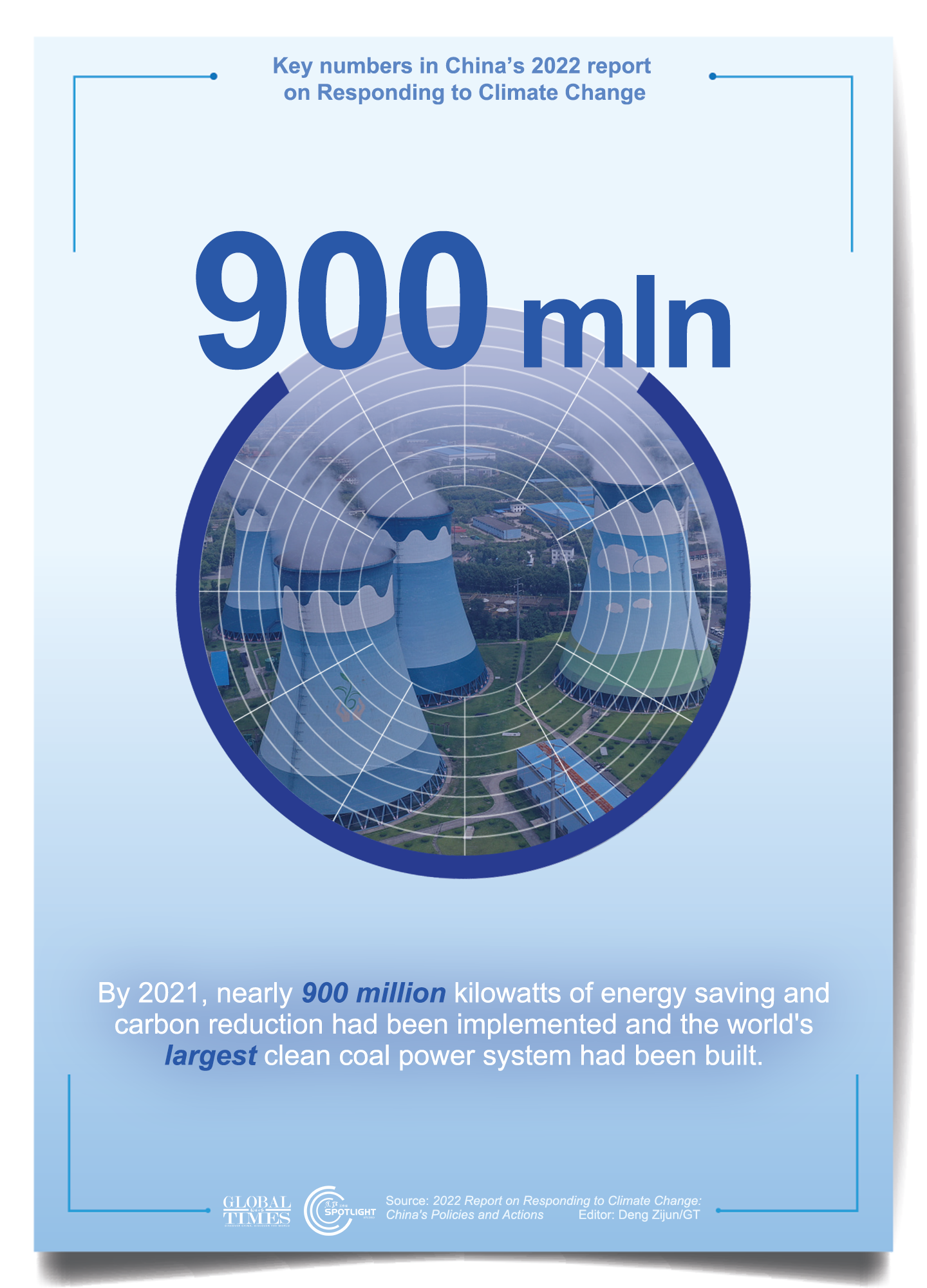China on Thursday presented its hard-earned achievements over the years on cutting emissions, such as CO2 emissions per unit of GDP being halved since 2005, and deepening cooperation on tackling climate change with the most affected South Pacific countries. With this year’s climate summit, known as COP27, drawing closer, those results are being seen as a demonstration of China’s efforts of fulfilling commitment of its pledge and a rebuttal of outside critics of such endeavor.
Experts said China’s determination of making these efforts, despite the current plight on energy and amid climate crisis, formed a sharp contrast to Western countries’ empty promises. They believed when the annual climate summit is in sight, the West should show their sincerity of solving global warming by fulfilling the promises of handing over lesser rich countries the financial commitment, instead of hijacking emerging economies to set aggressive targets, which will only disrupt friendly atmosphere for cooperation.
China’s Ministry of Ecology and Environment held a press conference on Thursday, elaborated China’s measures and actions on climate change. Li Gao, director general of the Department of Climate Change under the ministry said at the conference that CO2 emissions per unit of GDP have decreased 50.8 percent compared with that of 2005, and 3.8 percent lower than last year; and the share of non-fossil energy consumption increased to 16.6 percent.

Key numbers in China’s 2022 report on Responding to Climate Change Graphic: Deng Zijun/GT
It has also outlined measures of achieving emission goals such as kicking off pilot test in suitable cities and expanding climate change-related projects in certain places first.
Presenting those achievements before COP27, the annual UN meeting on climate, which will take place in Egypt from November 6 to 18, is part of the aim to show China’s achievement in fulfilling its international pledge on cutting emission, said Chinese experts.
“Those achievements and commitments are no walkover nor empty promises, given that this year the energy market is wrecked by the Russia-Ukraine crisis, which has led many rich countries to switch to coal; and natural disasters, including droughts and flood have gripped many parts of the world, including China itself,” Lin Boqiang, director of the China Center for Energy Economics Research at Xiamen University, told the Global Times on Thursday.
Blustery over promise
Lin noted that China’s gesture of making inroads despite current plight also formed a sharp contrast with hypocrisy of certain developed countries, especially the US, which used climate cooperation as disguise to slap trade barriers, or politicize this issue to pressure China.
In a recent interview with the Guardian, US Special Presidential Envoy for Climate John Kerry urged China to return to the negotiating table with the US on the climate crisis to kickstart stalled global progress on cutting greenhouse gas emissions.
China suspended climate talks with the US, which is one of the eight countermeasures China’s Foreign Ministry announced in August in response to the provocative visit of US House Speaker Nancy Pelosi to island of Taiwan.
The US has repeatedly urged China to return to the climate change negotiation table but skirted around the fundamental question of why China suspended those negotiations, and thus passed the buck on China for stalling the talks. Maybe the latest call is partly to “warm the atmosphere of throwing mud at China” before COP27, or for its midterm election, but the US should realize that any cooperation between the two cannot be isolated from the general atmosphere, Yang Fuqiang, a senior advisor on climate change and energy transition at the Energy Research Institute at Peking University, noting that the US is the one who bungled climate cooperation, and China won’t return to the negotiation table unless Washington shows intention to correct its wrongs.
Lin also pointed out that even if when China and the US were both at the negotiation table, Washington has frequently used climate change to wage trade barriers against China and crack down its renewable energy industry.
Using the so-called “forced labor” issue as an excuse, the US imposed sanctions on some Chinese photovoltaic enterprises in the Xinjiang Uygur Autonomous Region in 2021, an act that has not only undermined the cooperative atmosphere between China and the US, but has hindered renewable energy development around the world.
Although the US passed the Inflation Reduction Act in August, which contains hundreds of billions of dollars in subsidies for cleaner technologies and seen as a victory for the climate, poll by The Associated Press-NORC Center for Public Affairs Research recently shows that 49 percent of Americans say it won’t make much of a difference on climate change, and 14 percent think it will do more to hurt it.
The UN released a report on Wednesday saying that without drastic reductions in greenhouse gas emissions, the planet is on track to warm by an average of 2.1 to 2.9 degrees Celsius, compared with preindustrial levels, by 2100. That’s far higher than the goal of 1.5 degrees Celsius (2.7 degrees Fahrenheit) set by the landmark Paris agreement in 2015.
With data collected from 50 emerging economies, such as Thailand, Turkey, Israel and Kenya, a Chinese research paper led by Guan Dabo, a professor from the Department of Earth System Science at Tsinghua University said that although emerging economies emitted less than 1 percent of the global total, their total amount accounts for 1.6 times that of India, the world’s third-largest emitter.
Yet to restrict the global average temperature this century to well below 1.5 C above pre-industrial levels while leaving emerging economies enough space for further growth in emissions, developed nations need to reduce their carbon dioxide emissions by 7.2 percent per year on average, Guan said.
However, statistics show that from 2010 to 2018 the EU and the US saw their carbon emissions decrease by only 1.4 percent and 0.9 percent respectively.
This has raised pressing demand for developed countries not only to realize their negative emission goals, making room for emerging economies, but also to offer those countries technological and economic support, Guan told the Global Times.
Yet rich countries generally lag behind their promises to offer poorer countries assistance on climate change. Rich countries agreed in 2009 that at least $100 billion a year would be provided annually from public and private sector sources to the developing world by 2020, in order to help poor countries cut greenhouse gas emissions and cope with the impact of the climate crisis.
At the Thursday conference, Li also urged developed countries to fulfill their annual funding commitments of $100 billion as soon as possible, instead of just submitting a report during COP27 that makes excuses for the delay in fulfilling funding commitments.
“This has not only seriously affected and hindered the development of climate action in developing countries, but has also seriously damaged mutual political trust between developed and developing countries,” Li said.
A green collaborator
In contrast, China is sparing no effort in helping developed countries go greener. Li said that the low-lying South Pacific countries are the key collaborators with China on climate change, and currently China already has inked cooperation with countries such as Tonga, Samoa, Fiji and Kiribati, including assisting them in training professional personnel in dealing with climate change.
China made a promise last year that it would increase support for green and low-carbon energy in developing countries, and not build any new coal-fired power projects overseas.
China aims to enhance cooperation in multiple areas with the countries along the route of the Belt and Road Initiative by 2025 and form a green development pattern for the initiative by 2030, according to a guideline issued by the National Development and Reform Commission and three relevant departments in March.
He Kebin, an academician of the Chinese Academy of Engineering, and professor at the School of Environment of Tsinghua University, told the Global Times that China has demonstrated firm determination to help Belt and Road Initiative go greener, and in the future it will up the ante on investing in green and renewable energy on this initiative.
(Global Times)




